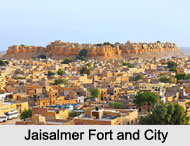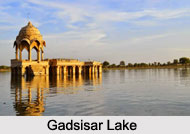 Jaisalmer is a medieval city dotted with Rajput architectures located at the heart of Thar Desert. This city earned the nick name "The Golden City", because of the presence of yellowish sandstone. Jaisalmer is also considered as the Jain pilgrimage destination after Girnar Hills in Gujarat. This city is beautified with many popular Jain temples which are erected with Rajput style of architecture.
Jaisalmer is a medieval city dotted with Rajput architectures located at the heart of Thar Desert. This city earned the nick name "The Golden City", because of the presence of yellowish sandstone. Jaisalmer is also considered as the Jain pilgrimage destination after Girnar Hills in Gujarat. This city is beautified with many popular Jain temples which are erected with Rajput style of architecture.
Location of Jaisalmer
Jaisalmer is located in Jaisalmer District of north western Indian state, Rajasthan. It is located very near to Pakistan border.
History of Jaisalmer
The history of Jaisalmer defines medieval era Rajput rule. The rule of Jaisalmer king began from the 9th Century. In 12th Century, the art and architecture of Jaisalmer reached at its peak. It was during the rule of Rawal Jaisal, Jaisalmer became the center of political culture. And from that time, Jaisalmer gained prominence in art and architecture till British era. During the rule of British East India Company, Jaisalmer became the Princely State.
Geography of Jaisalmer
Jaisalmer is geographically surrounded by Jangladesh region in the northern part and the east by Marwar region.
Climate of Jaisalmer
Jaisalmer enjoys the tropical and sub-tropical desert climate. The maximum summer temperature ranges from 49 degree Celsius to 25 degree Celsius, while the winter season enjoys 23 degree Celsius to 5 degree Celsius.
Economy of Jaisalmer
The economy of Jaisalmer is dependent on food crops and other agricultural items. Millet, jowar, wheat and barley are abundantly grown here. Jaisalmer is also a major supplier of oil and natural gases to the rest of Indian states.
 Culture of Jaisalmer
Culture of Jaisalmer
Jaisalmer is culturally enriched with Rajputana cult. Desert Festival is an important festival here hosts during the months of January or February.
Tourism in Jaisalmer
Jaisalmer Fort, Meru Hill, Lodhruva(Lodarva), Amarsagar, Brahmsar, Pokharan, Chandraprabhu Jain Temple, Desert Culture Centre and Museum, Jaisalmer Folklore Museum, Government Museum, Akal Fossil Park Museums, Kuldhara, Bada Bagh, Desert National Park, Gadsisar lake and Ganga Sagar are the prominent monuments and places of tourism that are located in and around Jaisalmer.
Visiting Information
Jaisalmer is reachable from all the cities of India and the cities of Rajasthan by roadways, airways and railways. The nearest airport is Jodhpur Airport, located in Jodhpur Division. Jaisalmer also has good railway connectivity with Bikaner, Lalgarh, Jodhpur, Ajmer, Pali, Jaipur, Alwar, Rewari, Gurgaon, Delhi, Ghaziabad, Muradabad, Kathgodam, Kashipur, Ramnagar, Lucknow, Gaya, Varanasi, Mughalsarai, Kolkata, Ahmedabad, Vadodara, Surat and Mumbai. The National highway 15 connects with all the districts of Rajasthan with Jaisalmer. Many buses are plying from Delhi, Agra, Lucknow, Ahmedabad, Mumbai and Pune to reach Jaisalmer.



















